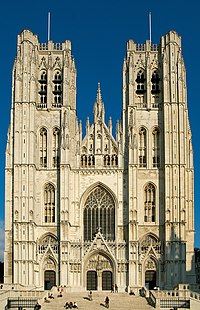St. Michael and St. Gudula Cathedral
| Cathedral of St. Michael and St. Gudula | |
|---|---|
| French: Co-Cathédrale collégiale des Ss-Michel et Gudule Dutch: Collegiale Sint-Michiels- en Sint-Goedele-co-kathedraal |
|
 |
|
| 50°50′52″N 4°21′37″E / 50.84778°N 4.36028°ECoordinates: 50°50′52″N 4°21′37″E / 50.84778°N 4.36028°E | |
| Location | Place Sainte-Gudule Brussels |
| Country | Belgium |
| Denomination | Roman Catholic |
| History | |
| Dedication | Gudula and Saint Michael (patron saints of Brussels) |
| Architecture | |
| Status |
Co-cathedral (Cathedral status from 1962) |
| Functional status | Active |
| Architectural type | Church |
| Style | Gothic |
| Years built |
c. 11th century (church) c. 13th century (towers) |
| Groundbreaking | c. 9th century (chapel) |
| Completed | 1519 |
| Specifications | |
| Number of towers | 2 |
| Number of spires | 2 |
| Spire height | 64 metres (210 ft) |
| Administration | |
| Archdiocese | Mechelen-Brussels |
| Clergy | |
| Archbishop |
André-Joseph Léonard (Primate of Belgium) |
| Dean | Claude Castiau |
| Laity | |
| Organist(s) | Xavier Deprez |
The Cathedral of St. Michael and St. Gudula (French: Co-Cathédrale collégiale des Ss-Michel et Gudule, Dutch: Collegiale Sint-Michiels- en Sint-Goedele-co-kathedraal) is a Roman Catholic church in Brussels, Belgium. The church was given cathedral status in 1962 and has since been the co-cathedral of the Archdiocese of Mechelen-Brussels, together with St. Rumbold's Cathedral in Mechelen.
A chapel dedicated to St. Michael was probably built on the Treurenberg hill as early as the 9th century. In the 11th century it was replaced by a Romanesque church. In 1047, Lambert II, Count of Leuven founded a chapter in this church and organized the transportation of the relics of the martyr St. Gudula, housed before then in Saint Gaugericus Church on Saint-Géry Island. The patron saints of the church, St. Michael and St. Gudula, are also the patron saints of the city of Brussels.
In the thirteenth century, Henry I, Duke of Brabant ordered two round towers to be added to the church. Henry II, Duke of Brabant instructed the building of a Gothic collegiate church in 1226. The choir was constructed between 1226 and 1276. It took about 300 years to complete the entire church. It was completed just before the reign of the emperor Charles V commenced in 1519.
...
Wikipedia
